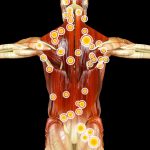JARED L. ZEFF, ND, VNMI, LAC
The following is not an article prepared for a medical journal. Not every statement of fact is cited or referenced. This is a commentary on the medicine, a running set of observations about practice in the field. It’s not meant to be a peer-reviewed presentation; rather, these are notes and thoughts from a practicing naturopathic physician, a primary care doc in general practice.
The Efficacy of Manipulation
An older woman once came into my office with a chief complaint of back pain that had persisted for nearly 2 years. She sat in her chair with a pinched and uncomfortable expression. She mentioned that she had an L4-L5 vertebral misalignment that had been bothering her. The pain made it hard to sleep or move normally. She’d had several X-ray studies done and was told there was minor disc deterioration. Her chiropractor was treating her regularly, but the pain persisted. When I asked her how the chiropractor adjusted her, she told me that he pushed on her back while she was prone on the table. I took her into an exam room, and as I felt along her spine, I could feel the area of disturbance. The L4-L5 area was quite tender bilaterally, as were the sacroiliac (SI) joints. I took her to a treatment room and did a simple high-velocity low-amplitude (HVLA) lumbar manipulation – what we used to call a “lumbar roll” – focused in the L4-L5 area. I followed this with a Bowen-type release of the back and hips.
When my patient felt the “pop” with the first lumbar manipulation, she seemed surprised. She reported feeling a flush move from her back through her whole body. After I had finished the procedure and had her stand, she reported feeling profoundly different. As we walked back to my office from the manipulation room, she said she felt a new ease. She was moving more fluidly and standing straighter. She also sat in her chair straighter, but more relaxed. She was smiling and her pinched, compressed expression was gone. I completed the visit and asked her to call me in a few days to let me know how her back was doing. She called a few days later and told me it was hard to believe, but her back felt better than it had in 2 years. She had no pain.
A “Second Opinion”
Several years ago, a 79-year-old woman came to see me. She had been my patient for several years. I had treated her for gastritis, hypertension, and congestive heart failure, and we always seemed to help her. She limped into my office this day and said that she was just told that she needed hip replacement surgery. It had already been scheduled, but she contacted me because she wanted a second opinion.
I was a bit concerned about this. She had no history of hip pain or limitations in her range of motion. Generally, hip replacements are not acutely needed. Hip degeneration develops slowly, with a growing sense of pain and limited movement. I asked her what had happened. She let me know that her hip had suddenly started hurting, so she went to the doctor. They did x-rays and told her that her hip was “no good,” and she needed it replaced. They gave her acetaminophen with codeine, but it did not help. She had to stay in bed due to the pain.
I asked her to tell me in greater detail what had happened. She then told me that she had been working in her orchard. She was a very vigorous woman, and at the age of 79, outworked most of the people she hired to help around her farm. She was shoveling some irrigation ditches in the orchard without any difficulty, but the next morning, her hip began hurting her severely. Just to clarify, I asked her if her hip had been hurting before the shoveling. She assured me that it had never bothered her previously.
I had her lie down on an exam table. Her right SI joint was displaced and there was spasm in the right psoas and gluteal muscles. I put some heat on her hip, and then I did an HVLA manipulation to the right SI joint, followed by a Bowen-type release. She got up from the table without pain. She was very surprised. I told her that I thought the shoveling overworked the hip and stressed the SI joint, which then became displaced. I simply relaxed the muscles with the heat and then put the joint back into place with the adjustments. She did not need a hip replacement. She cried a bit and thanked me, then cancelled the surgery. I have seen her several times since, and her hip has not been a problem.
Learning the Skill
Each day, I usually do at least 1 manipulation, and often I do several. It is a simple process and requires no special equipment – just one’s hands, a bit of training, skill, and an appropriate table. I use a padded massage-type table, though a drop table is also fine. There are many methods of manipulation, and in school we were trained in the most basic HVLA techniques. My initial teacher, Jack Dougherty, was a chiropractor as well as a naturopathic physician. He had studied at Western States Chiropractic College in Portland, where he also taught chiropractic adjustment techniques. Our course was very practical, with lots of hands-on training, and we often practiced on each other.
I remember practicing on a classmate one day who wanted a neck adjustment. I had learned the procedure: First, take the neck to tension with the proper angle based upon the vertebra that needed correction, then relax a bit, apply some force against the tension, and…crack! Usually, this was a satisfying result. But performing neck adjustments scared me; I did not want to hurt anyone. I tried to be very careful and gentle, but in doing so, I botched it. She told me to just adjust her and quit messing around. I took the challenge and on my next try, worrying less about hurting her, I did a better job. Then I began to hang around the manipulation classes to get extra practice. Pretty soon, I was looking forward to those scary neck adjustments because I was having some success with a bolder approach, and that was the trick.
Non-Force Techniques
I was academic dean at the National College of Naturopathic Medicine (NCNM) in the late 1980s. During one of those years, a man from Australia came to the AANP convention at the Biltmore Hotel in Phoenix. He announced that he was giving demonstrations of an Australian manipulation technique created by a man named Thomas Bowen. I attended one of these. He told us that he was in the US to teach this method and was looking for venues. I invited him to NCNM to do a seminar on the technique. I attended that first seminar. He returned several years in a row to continue the trainings. I was given a certificate of completion and a booklet of instructions for specific manipulations. I put it on my shelf and soon forgot about it.
A few years later, when I was back in private practice, I got a call from a man who wanted to know whether I had ever treated torticollis. I told him I had treated it successfully several times before. He made an appointment to come to my office. I looked forward to his visit, knowing that treating him should be easy. With acupuncture and HVLA manipulation, I had corrected this condition before, so I had great confidence that I could help this man.
A few days later he walked into my office at the appointed time, and as he walked in the door, he said very emphatically, “No needles! I hate needles!” He then said that he could not tolerate that “chiropractic cracking stuff” either. “Uh oh,” I thought. “What now?” He had just eliminated my treatment plan. Then I remembered that I had taken the Bowen seminars several years before, and there was some neck work we had learned. I put him in a treatment room, told him to relax on the table, and said that I would be back in a minute. I went to my file cabinet, found that old Bowen booklet, and read through the part on neck manipulation. When I returned to the treatment room and performed the Bowen releases, his neck eased and straightened. He was very happy, and I was remember feeling relieved.
There are several effective non-force manipulation techniques. The Bowen method is one of them. I think every doctor should master at least 1 non-force technique in addition to the classic HVLA method.
An Important Part of Naturopathic Medicine
Jim Sensenig, ND, followed the advice of John Bastyr, ND, who said that we should manipulate every patient. Why? Among other things, it puts one into physical contact with the patient, and most patients like physical contact. Often, they feel and function better immediately because of manipulation. I admit that I do not manipulate every patient. I generally do so only when they have a musculoskeletal misalignment that I think will benefit from manipulation. But John was still correct in his thinking. Almost everyone can benefit from manipulation, most of the time, and I should really try to do it more.
Manipulation has been part of naturopathic medicine from the beginning. As Benedict Lust was establishing our profession, he studied at a standard medical school to obtain his MD degree. He also studied osteopathic and chiropractic medicine, obtaining degrees in both fields in the late 1800s. Lust wanted it to be clear that he was a trained physician in all the major medical systems of the time, that our profession was among these major systems, and that it included legitimate training. He conceived of our profession as an umbrella under which all the various natural healing methods could come together. We would be trained in the best of them and be fluent in their application. These included the osteopathic and chiropractic manipulative systems. Early doctors referred to this work as “physical corrections.” Sussanna Czeranko, ND, of Saskatchewan, has written about this in the Hevert Collection on naturopathic history, particularly in the volume titled Physical Culture in Naturopathic Medicine: In Their Own Words.
Closing Thoughts
Manipulation, in general, is a technique that is best applied after the diet and digestion are in order and underlying causes of disturbed physical function have been corrected. This corresponds with the Naturopathic Therapeutic Order that I established along with the help of Pamela Snider, ND. At that point, a simple manipulation realigns the physical structure in a system that is then better able to maintain the corrections introduced. There are times when manipulation is a first-order therapy, such as when the chief complaint is a physical trauma. But even then, it is important to remember that when the organs and systems are in better functional order, fewer manipulations may be required to result in permanent correction.
Manipulation is a fundamental tool in the therapeutic kit of any naturopathic physician, and one that tends to be neglected. I have presented these 3 cases and this history to help make the case for the continued importance of manipulation in daily practice, regardless of specialty.
Respectfully,
Jared L Zeff, ND, VNMI, LAc





